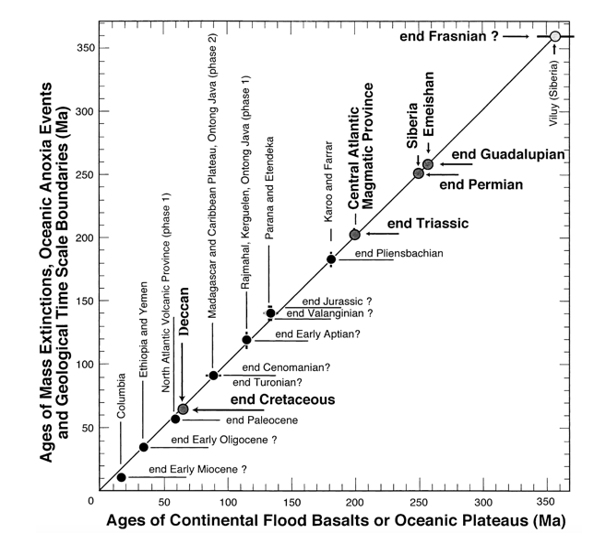50 Supervolcanoes
Yellowstone Caldera
The largest supervolcano in North America is beneath Yellowstone National Park in Wyoming. Yellowstone sits above a hotspot that has erupted catastrophically three times: 2.1 million, 1.3 million, and 640,000 years ago. Yellowstone has produced many smaller (but still enormous) eruptions more recently (Figure 2). Fortunately, current activity at Yellowstone is limited to the region’s famous geysers.
The Old Faithful web cam shows periodic eruptions of Yellowstone’s famous geyser in real time.
 Figure 2. The Yellowstone hotspot has produced enormous felsic eruptions. The Yellowstone caldera collapsed in the most recent super eruption.
Figure 2. The Yellowstone hotspot has produced enormous felsic eruptions. The Yellowstone caldera collapsed in the most recent super eruption.Web Cam from Yellostone Park: https://www.nps.gov/yell/learn/photosmultimedia/webcams.htm
 What would cause such a giant caldera?
What would cause such a giant caldera?
You can stand on the rim and view the enormous Yellowstone Caldera, but it’s hard to visualize a volcano or a set of eruptions that enormous. Supervolcanoes are a fairly new idea in volcanology. Although their eruptions are unbelievably massive, they are exceedingly rare. The power of Yellowstone, even 640,000 years after the most recent eruption, is seen in its fantastic geysers.
Supervolcano eruptions are extremely rare in Earth’s history. It’s a good thing because they are unimaginably large. A supervolcano must erupt more than 1,000 cubic km (240 cubic miles) of material, compared with 1.2 km3 for Mount St. Helens or 25 km3 for Mount Pinatubo, a large eruption in the Philippines in 1991. Not surprisingly, supervolcanoes are the most dangerous type of volcano.
Supervolcano Eruptions and Life on Earth
A supervolcano could change life on Earth as we know it. Ash could block sunlight so much that photosynthesis would be reduced and global temperatures would plummet. Volcanic eruptions could have contributed to some of the mass extinctions in our planet’s history. No one knows when the next super eruption will be.
New discovery of continuous lava eruptions on Kergelen Plateau: across the 30 million or so years of intense activity, the Kerguelen Plateau rose by about 20 centimetres (7.87 inches) a year, the researchers say. Across the gigantic size of this large igneous province – about three times the size of Japan – the outpouring equates to lava filling 184,000 Olympic-sized swimming pools per year: https://www.sciencealert.com/a-huge-magma-conveyor-belt-fuelled-the-world-s-longest-burst-of-supervolcanoes
Supervolcano activity was part of the Earth’s life in the past.
One of the most amazing evidences of this activity is a finding of so-called “flood basalts” in various parts of the world.
These basalts occupy large areas in various continental and oceanic parts of the earth. The video below explores this phenomenon in relation to biologic extinctions and climate change.
Source: Courtillot & Renne (2003). Impact of Flood Basalts, ages of mass extinctions.
Summary
- Supervolcano eruptions are rare but massive and deadly.
- Yellowstone Caldera is a supervolcano that has erupted catastropically three times.
- Supervolcano eruptions can change the course of life on Earth.

